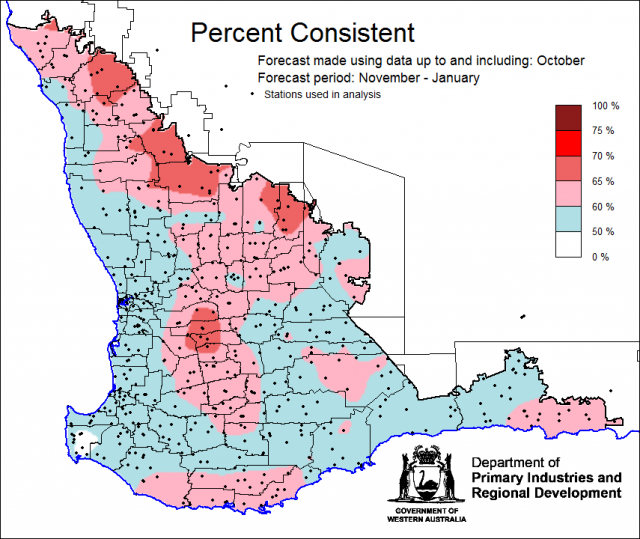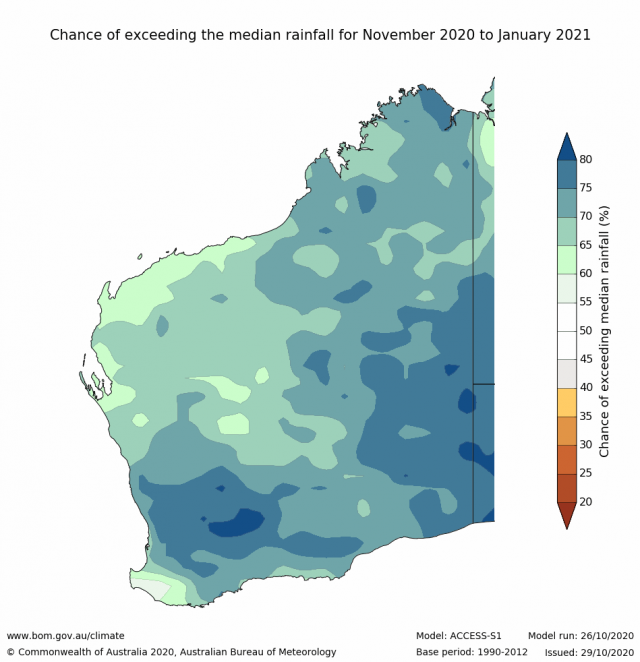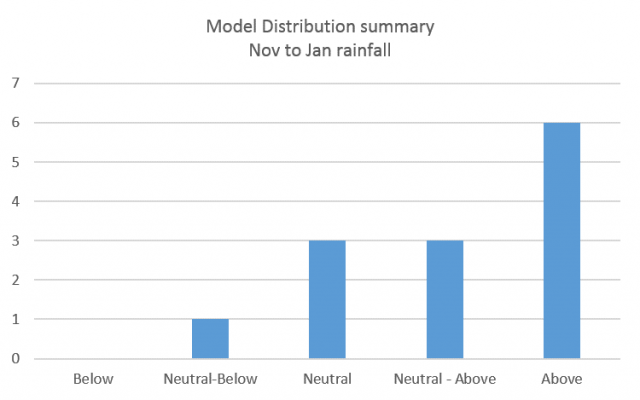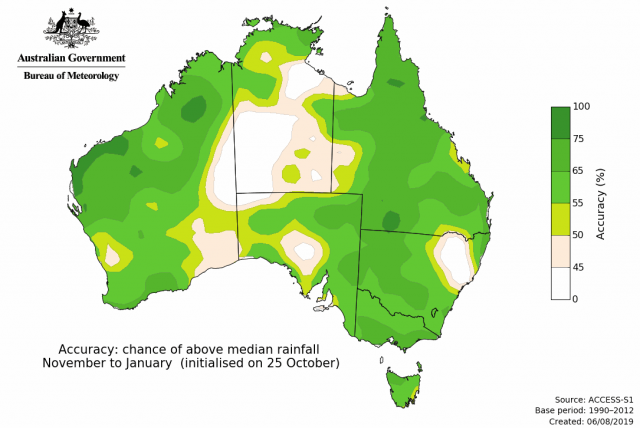Summary
The Department of Primary Industries and Regional Development’s (DPIRD) Statistical Seasonal Forecast (SSF) outlook for November 2020 to January 2021 is 40-80% chance of exceeding median rainfall for the majority of the South West Land Division (SWLD).
- For November 2020 to January 2021, the SSF i is indicating 40-80% chance of exceeding median rainfall for the majority of the SWLD. The higher chances are for the Central West and Central Wheatbelt forecast Districts. For South East Coastal District, parts of the Great Southern and Central Wheatbelt Districts, chances are lower at 20-40%. The most probable rainfall decile map indicates decile 4-7 for the majority of the SWLD. Predictive skill based on October conditions is mostly poor to medium (50-70% consistent).
- The Bureau of Meteorology’s seasonal outlook for November 2020 to January 2021 is indicating 50-80% of exceeding median rainfall for the majority of the SWLD. Predictive skill is poor to good (45-75% consistent). The longer-term outlook for December 2020 to February 2021 gives higher chances at 70-80%. Predictive skill is moderate to good (55-75%).
- Temperature outlooks for November to January 2021, from the Bureau indicate a 65-80% chance of above average day-time maxima along the west coast, with lower chances (30-60%) for the south coast and interior (high skill 75-100%) and 80% chance of above average night-time minima (high skill 65-100%) for the SWLD.
- October rainfall was below average in the SWLD. October maximum and minimum temperatures were very much above average.
- The La Niña in the tropical Pacific Ocean, together with a positive SAM are currently the main climate drivers influencing SWLD climate. In a La Niña, there is an increased chance of above average number of tropical systems (cyclones and lows) across northern Australia. This may lead to more summer rainfall in the SWLD. A positive SAM means westerly winds are further south than normal and this may increase temperatures in the SWLD.
Three Month Outlook for the south-west of Western Australia
Statistical Seasonal Forecasting (SSF)
DPIRD’s Statistical Seasonal Forecast (SSF) system uses historical relationships between global sea surface temperature and sea level pressure with rainfall in south-west Australia to produce forecasts of rainfall for the coming months. Users can click on any station indicated on the map for location-specific forecast information from the Seasonal Climate Information web page.
For November 2020 to January 2021, the SSF is indicating a 40-80% chance of exceeding median rainfall for the majority of the South West Land Division. The higher chances are for the Central West and Central Wheatbelt forecast Districts. For South East Coastal District, parts of the Great Southern and Central Wheatbelt Districts, chances are lower at 20-40%. The most probable rainfall decile map indicates decile 4-7 for the majority of the SWLD. Predictive skill based on October conditions is mostly poor to medium (50-70% consistent).


Bureau of Meteorology seasonal climate outlook
The Bureau of Meteorology's climate forecast system for monthly and seasonal climate outlooks is the Australian Community Climate Earth-System Simulator – Seasonal (ACCESS–S). It is a dynamical (physics-based) forecast modelling system and is a collaboration between the Bureau of Meteorology and the UK Meteorological Office.
The Bureau of Meteorology’s seasonal outlook issued on the 29 October indicated a 50-80% of exceeding median rainfall for November 2020 to January 2021 for the majority of the South West Land Division. Predictive skill is poor to good (45-75% consistent). The longer-term outlook for December 2020 to February 2021 gives higher chances at 70-80%. Predictive skill is moderate to good (55-75%).
Temperature outlooks for November to January 2021, from the Bureau indicate a 65-80% chance of above average day-time maxima along the west coast, with lower chances (30-60%) for the south coast and interior (high skill 75-100%) and 80% chance of above average night-time minima (high skill 65-100%) for the SWLD. These outlooks can be found at http://www.bom.gov.au/climate/ahead/outlooks/archive/20201029-outlook.shtml .

Looking at other rainfall forecasting models, the majority are indicating above chances of exceeding median rainfall for November to January 2021 for the SWLD.

Recent climate
October rainfall was below average in the SWLD. October maximum and minimum temperatures, were very much above average. Growing season rainfall (April to October) was generally below average in the SWLD.
In October, the atmospheric pressure was slightly higher than normal over the SWLD.
Sea surface temperatures of the Indian Ocean north of Western Australia are warmer than average, this may be favourable for enhancing rainfall over the continent. The November 2020 to January 2021, SST forecast by the Bureau of Meteorology indicates SSTs are likely to remain warm to the north of WA.
The Southern Annular Mode (SAM), also known as the Antarctic Oscillation (AAO), describes the north–south movement of the westerly wind belt that circles Antarctica, dominating the middle to higher latitudes of the southern hemisphere. SAM is currently positive and is expected to remain positive over the 2020-21 summer. La Niña tends to favour positive SAM during the spring to summer months, which typically enhances the wet signal of La Niña in parts of eastern Australia. A positive SAM in summer has little effect on rainfall for WA, but increases temperatures as westerly winds are further south than normal, reducing the sea breeze along the WA coast. For more information see the Bureau of Meteorology’s Climate Driver Update.
The Indian Ocean Dipole (IOD) is neutral after tending towards positive values in recent months. With the Australian monsoon commencing, the IOD is likely to remain neutral through summer.
La Niña continues in the tropical Pacific. Australian and international climate models suggest it is likely to continue at least into February 2021. A La Niña is often associated with increased chance of widespread rains and flooding over eastern, central and northern Australia, more tropical cyclones than average and prolonged very warm periods in the south. In a La Niña, there is an increased chance of above average number of tropical systems (cyclones and lows) across northern Australia. The first Australian landfall typically occurs in early December, which is about 3 weeks earlier than usual. For further information, see the Bureau of Meteorology’s Australian Tropical Cyclone Outlook and the Northern Rainfall Onset.
The table below gives a summary of past month and three-month South West Land Division (SWLD) climate conditions, and can indicate what is likely to occur in the near future if climate conditions follow the current pattern.
| Climate Indicator | Past month | Past 3 months |
|---|---|---|
| SWLD Rainfall | Below average | Below average to average |
| SWLD Mean Temperature | Very much above average | Above average |
| SWLD atmospheric pressure | Higher | Higher |
| Indian Ocean Sea surface temperature | Warmer | Warmer |
| El Niño/Southern Oscillation (ENSO) | La Niña | La Niña |
| Indian Ocean Dipole (IOD) | Neutral | Neutral |
| Southern Annular Mode (SAM) | Positive | Negative |


